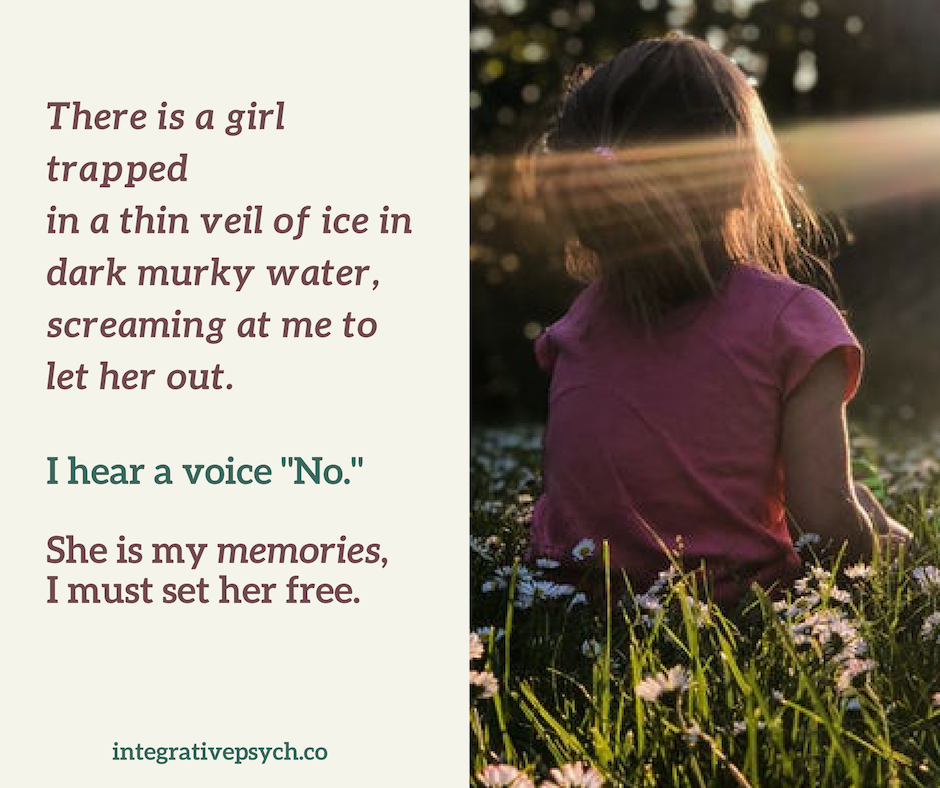Emerging Trauma Memories? + 4 Coping Tips!
“Something is wrong with me, and I think I’m going crazy. I know my life wasn’t perfect, but suddenly I’m flooded with images I never knew existed and I can barely function. What’s wrong with me?”
“I know I had trauma and/or anxiety, and I did some good talk therapy years ago, but suddenly it’s coming back with a whole new force, how do you explain this? And will it ever get better?”
When clients come in saying they’ve been ok, but suddenly there are feelings, emotions, memories or flashbacks from the past, they are often perplexed, scared and confused.
Reemergence - A Message from the Trauma Holding part that you’re Safe Enough now to Process.
Reemergence of memories usually means that there was some form of trauma, abuse, neglect or emotional hurt that was experienced years ago, but was repressed because you were not in a safe or stable enough place to heal it.
Maybe you weren’t surrounded by others who would trust you, maybe you were too young, were still in a dangerous situation or had medical or personal stressors that didn’t allow looking inward.
The science behind why trauma “hides” and later “reappears”
Trauma healing isn’t a simple 1—2—3 step process. If you’ve experienced abuse, shock, loss, neglect, violation, assault, violence or witnessed any of the above, you may initially shut down the emotional memory because the intensity of the emotions are too much to “digest”.
The human brain and body learn to put these into a “deep freeze” so it can get back to functioning in day-to-day life; showing up to school, work , perform duties and tend to relationships.
However, even when stored away, the body always remembers.
Even when memories are hidden, they don’t ever completely dissipate. Most trauma survivors experience triggers which are reminders to their unconscious mind of the past.
They may have nightmares that are metaphoric to the danger experienced, or may have flashbacks of images of what happened - often, without fully understanding what it’s all about. These are the ways the body holds onto the memory- no matter how much time passes, the body remembers all experiences.
Since it’s never fully “gone” from the system, eventually there will be a time where it comes spinning back in.
Why does this happen? Because you’re safe enough now. There’s a younger part of self that is inside that holds the experiences it’s gone through. When that part notices that you’re in a stable place in your life, or for the first time you’re in a place of safety, these memories come knocking - wanting to be heard, processed and resolved.
The emotions of anger, sadness, confusion, heartache, terror, loneliness, helplessness or fear come out- metaphorically, asking you to sit with them, and let them be heard, and expressed, in the presence of your current life.
These emotions have been waiting patiently on the side while you were getting stronger, and as you gained coping skills to navigate the world in a whole new way.
Memories from the past- a persistent request for deeper living, loving and experiencing.
In the past, these emotions would have been too painful or complex to open up, and your body knew it wouldn’t have been able to adequately process what it needed.
So, if you’re in this space where memories, sensations, an underlying hum of anxiety, new flashbacks or fragments of memories are suddenly resurfacing, how can we help you stay strong while being vulnerable?
4 Tips to Stay Steady + Ditch the Overwhelm when Memories Arise
1) Reassure, Reassure, Reassure.
Repeat after me, “I am not going crazy.” This is how your mind, body and nervous system are processing old fragments of memory. It can be incredibly uncomfortable, fear-inducing and even confusing, but none of those mean that you’re going “nuts”. These seemingly new emotions are actually a healthy and normal part of trauma recovery.
You’re not sliding backwards; you’re actually ready to do a deeper level of healing, so brace yourself instead of hitting the panic button.
2) Pace, Pace, Pace.
Know quote that says “slow and steady wins the race”? In trauma healing, “winning” is living a life without trauma symptoms and experiencing relief that lasts, so slow and steady most definitely is the way to go! Emotions can come like a whoosh of feelings that are overwhelming and frightening, so your job is to slowly pace yourself { and in therapy, of course with the help of your therapist.}
You’ll want to imagine a syringe where you can only administer tiny droplets at a time, pacing the work so you stay grounded in your skin.
There may be an urge to think, feel and process everything at once {on your own, or in therapy}, but then you take a risk of flooding yourself and becoming re-traumatized instead of stabilized.
For day-to-day, you can set aside ten to twenty minutes to journal, draw or chat with a friend or loved one about what is coming up for you. You want to offer space for these new experiences, but you want to ensure that they aren’t lop-siding your life, or robbing you from your daily functioning behaviors that you actually need, especially now.
Skills for Day-to-Day Relief.
Code Words: You can use "code words" for example; for intrusive memories- “dark”; and a code word for tuning back into daily here-and-now life-“light”. You can practice this on your own or in your therapy session, as this will teach you mind the ability to healthily compartmentalize when needed.
Distancing Techniques: You can train your mind to distance itself from intrusive thoughts, sensations or images. One way is to imagine a dimming switch where you imagine dimming the light, weakening the intensity and take control over the “knob” that is connected to the image or whatever uncomfortable sensations you’re experiencing. You can also draw a remote control and mentally download it into your mind. Then imagine using it when needing to “switch the channel” of whatever is playing in your mind.These, amongst many other skills, are ways to help you brain practice ways to stay regulated, so you can do the healing work at a pace that is refreshing and not rushing.
3) The only way “out” is through.
You may have a strong urge to just pull avoid, avoid or distract from what is going on, and shove it back away in storage. That would make so much sense, as it’s no fun to feel uncomfortable, or frightened. However, I want you to know that these emotions ride through, out, and go away, but only after they are felt, validated, given words and are offered healing {there are various trauma resolution methods to help with this- such as EMDR, Somatic Methods, Expressive and Narrative Therapies).
I’ve seen those who stay focused, trusting and committed to healing really experience relief and have the most positive treatment outcomes in the long-run.
4) Inspiration for continued Progress.
Though you may be hesitant to notice your progress while you’re in pain, it’s imperative that you make it your focus to notice any form of progress or movement, no matter how big or small.
These emotions, memories or experiences were dug deep, and because of that, they will not pass in one therapy session, but they will subside.
Often, healing is compared to waves in an ocean. There will be days of calm, days of intense sadness, feelings of anger or even a week of frustration that may have no words. These are all nonverbal communications from your body that it’s processing, feeling and releasing past experiences.
I’ve seen people get stuck and almost want to give up when these happen, because it can feel discouraging.
Because of this, I encourage keeping a log, or a journal where you rate your days, something as simple as 1-10 rating your mood- and tracking over a period of a few weeks or months. In this context, even one super hard week or a tough, emotionally fragile month, can seem like a wave when you see there was an uptick in social interaction and more intimacy and connection with your kids the weeks after.
Tracking progress and change is vital, to keep the hope and motivation in staying committed to your healing.
If journals aren’t your thing, you can confide in a loved one, friend or therapist who can help remind you of your overall movement- anchoring you in trust while the waters may get choppy.
If you’re in the thick of it, know that this is one of the hardest experiences to go through; and at the same time, it’s an offering for deeper healing.
When it passes, you’ll be more whole than before.
Many have walked this path, and most, felt confused, were misunderstood and got through by holding on to hope, taking it minute by minute, or second by second. As fragments of information come together, the psyche calms down and you re-settle into regular functioning.
If you’re reading this and aware that you’re needing some one-on-one support, a trauma trained therapist can help you move through this phase of memory, and/or the trauma and anxiety that’s suddenly come up.
At Integrative Psychotherapy, we’ve made it our goal to educate and help those in the healing process, and make recovery one that is transparent, focused and progress oriented.
Our therapists utilizes scientific-based methods including Eye Movement Desensitization and Reprocessing, Somatic & Sensorimotor Psychotherapy, Parts Work/ Ego State Work, Expressive Arts and Cognitive Talk Therapies.
We want you to experience short term relief as well as relief that lasts way beyond your time on the therapy couch.
If you’re ready to do the work, reach out today, we’d be happy to help you experience relief today!








